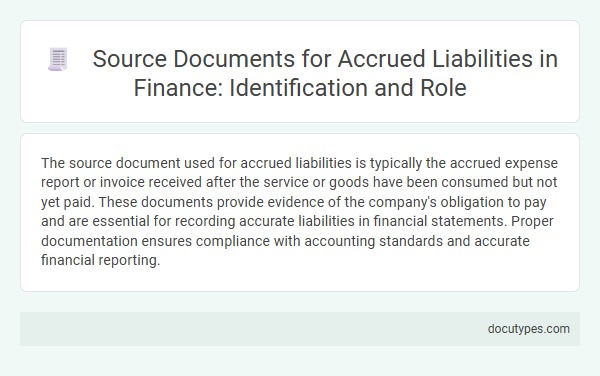The source document used for accrued liabilities is typically the accrued expense report or invoice received after the service or goods have been consumed but not yet paid. These documents provide evidence of the company's obligation to pay and are essential for recording accurate liabilities in financial statements. Proper documentation ensures compliance with accounting standards and accurate financial reporting.
Introduction to Accrued Liabilities in Finance
Accrued liabilities represent expenses that a company has incurred but has not yet paid. These liabilities are essential for accurately reflecting a company's financial position during an accounting period.
The primary source document used for accrued liabilities is the accrued expense report or invoice. You rely on these documents to ensure all unpaid expenses are recorded correctly in your financial statements.
Definition and Importance of Source Documents
Which source document is used for accrued liabilities? Source documents for accrued liabilities typically include invoices, contracts, and time sheets that confirm expenses incurred but not yet paid. These documents are crucial for accurately recording financial obligations and ensuring proper accounting compliance.
Common Types of Source Documents for Accrued Liabilities
| Source Document | Description | Relevance to Accrued Liabilities |
|---|---|---|
| Invoices | Documents received from vendors or service providers listing amounts due for goods or services delivered but not yet paid. | Used to record expenses incurred but unpaid at the end of an accounting period, forming the basis for accrued liabilities. |
| Time Sheets | Records of employee hours worked, often used to calculate payroll expenses. | Help determine wages payable that have been earned but not disbursed, contributing to accrued wage liabilities. |
| Contracts or Agreements | Legal documents outlining service terms, payment schedules, or ongoing obligations. | Provide evidence of services performed or expenses incurred which require accrual even if no invoice has been issued yet. |
| Utility Bills | Statements showing charges for utilities such as electricity, water, or gas used during a billing cycle. | Often received after the accounting period end; necessary for accruing utility expenses incurred but not billed. |
| Expense Reports | Employee-submitted summaries of business expenses needing reimbursement. | Support accrual of miscellaneous expenses that have been incurred but not yet paid. |
| Purchase Orders | Formal requests issued to suppliers to procure goods or services. | Useful for verifying obligations and expected costs that may require accrual to accurately reflect liabilities. |
You should carefully review these common source documents to ensure your accrued liabilities accurately reflect all outstanding obligations during financial reporting.
Key Characteristics of Valid Source Documents
Source documents used for accrued liabilities must provide clear evidence of expenses incurred but not yet paid. These documents validate the accuracy and timing of the liability recorded in the accounting system.
Key characteristics of valid source documents include detailed descriptions of goods or services received, the date of the transaction, and the amount owed. Invoices, purchase orders, and contracts often serve as reliable source documents. They ensure compliance with accounting standards by supporting the recognition of accrued expenses.
Identification Process for Source Documents
The source document used for accrued liabilities is typically the employee timesheets, invoices, or service agreements that confirm the amount owed but not yet paid. Identification of these documents requires thorough review of outstanding obligations and matching them with corresponding internal records. Accurate recognition ensures that all expenses are recorded in the correct accounting period, maintaining financial statement integrity.
Role of Source Documents in Financial Reporting
Source documents play a crucial role in accurately recording accrued liabilities in financial reporting. These documents provide verifiable evidence for expenses incurred but not yet paid, ensuring your financial statements reflect true obligations.
- Invoices - Used to confirm amounts owed for goods or services received but not yet paid.
- Expense Reports - Provide detailed records of employee-incurred expenses that contribute to accrued liabilities.
- Contracts and Agreements - Establish the terms and timing of expenses that must be accrued in the financial statements.
Using accurate source documents ensures your accrued liabilities are properly documented and reported.
Examples of Source Documents Supporting Accrued Liabilities
Accrued liabilities require precise source documents to ensure accurate financial reporting. Understanding which documents support these liabilities helps maintain your accounting integrity.
- Invoices for Unpaid Services - These documents confirm services rendered but not yet paid, validating the accrued expense.
- Payroll Records - Details of wages earned by employees that have not been disbursed are essential for recording accrued salaries.
- Utility Bills Received After Period-End - Statements received post reporting period that pertain to the period help in recognizing accrued utility expenses.
Best Practices for Managing Source Documents
Source documents for accrued liabilities typically include invoices, purchase orders, and timesheets that verify the obligations incurred but not yet paid. These documents serve as critical evidence for recording accurate financial statements and ensuring compliance with accounting standards.
Best practices for managing source documents involve organizing them systematically, such as using digital filing systems with clear labeling and secure backups. You should regularly review and audit these records to maintain accuracy and streamline the reconciliation process.
Regulatory Requirements and Compliance Considerations
Accrued liabilities require precise source documentation to ensure regulatory compliance and accurate financial reporting. The source document must validate the obligation incurred but not yet paid, aligning with accounting standards and audit requirements.
- Invoice or Vendor Statement - This document substantiates the amount owed for goods or services received, ensuring compliance with payment obligations.
- Contracts or Agreements - These outline terms that trigger liability recognition, supporting adherence to regulatory standards and accounting principles.
- Internal Expense Reports - These provide evidence of incurred expenses not yet invoiced, critical for accurate accrual and regulatory audit trails.
Which Source Document Is Used for Accrued Liabilities? Infographic

